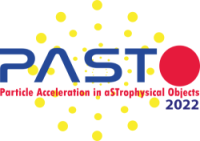Speaker
Description
Novae, among the brightest transients in the night sky, are luminous eruptions occurring in a binary system in which a white dwarf accretes mass from a stellar companion. As an accreted layer accumulates conditions are reached for a thermonuclear runaway. The resulting energy release causes the accreted envelope to expand, leading to its ejection. During this process shock waves are produced that provide extreme conditions required to accelerate particles to high energies. Novae are valuable laboratories for studying time-dependent shock particle acceleration. Evidence of the presence of high-energy particles in these systems are the detections of radio synchrotron emission, of gamma rays in the range $\sim$ 100 MeV to $\sim$ 10 GeV, and of very-high-energy radiation ($>$ 100 GeV) with the very recent detection at these energies of the recurrent symbiotic nova RS Ophiuchi. I present here a spatial-temporal model for the non-thermal emission of RS Ophiuchi. The model solves the transport of relativistic particles, electrons and protons, injected inside the system, computing the produced radiation. Additionally, the model estimates the particle escape into the interstellar medium.

